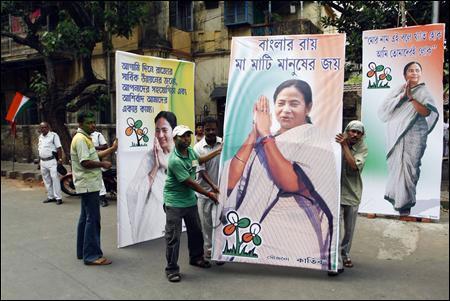
This flows from West Bengal's unusually high level of government debt (more than 40 per cent of the state's GDP), bequeathed to her as the fruit of 34 years of Left Front rule.
The debt is about twice the all-state average, and has resulted in an interest burden that eats up 29 per cent of the state's revenue.
The next worst state is Punjab, with 18 per cent of revenue used to pay interest. So West Bengal Finance Minister Amit Mitra has a point when he says heavy interest payments are eating up money that could usefully have been deployed for development schemes.
Click on NEXT for more...

Should the Centre have done something to help? That's hard to tell, because while West Bengal has an unusually large debt problem, its finances would be in a mess even if there were no debt.
The Reserve Bank's study of state finances for 2011-12 shows that West Bengal was one of just three states that had a deficit even without counting the interest on debt (the other two were Punjab and Haryana).
And if you take the total fiscal deficit, West Bengal is by no means the worst off: it had a deficit that was 2.9 per cent of the state's GDP, but Goa had a deficit of 4.8 per cent, Punjab 3.8 per cent, Kerala 3.4 per cent, Jharkhand 3.3 per cent and Madhya Pradesh 3.0 per cent, while Andhra Pradesh and Uttar Pradesh were at West Bengal's level.
So how is the Centre to give special treatment to one state, without getting competitive demands from others? Indeed, Uttar Pradesh, Punjab, Goa and Kerala are already in the queue.
Click on NEXT for more...

It is not that the Centre has done nothing. It may not have obliged the Trinamool Congress government in Kolkata by agreeing to its demand for a three-year moratorium on interest payments.
But it seems to have gone out of its way to lend a hand, as the state's budgets show. Grants-in-aid to the state in 2010-11, the year before Ms Banerjee became chief minister, totalled just under Rs 10,000 crore (Rs 100 billion).
In the Trinamool government's first year (2011-12), the grants shot up to Rs 12,750 crore (Rs 127.5 billion).
And this year Amit Mitra has budgeted to get Rs 20,282 crore (Rs 202.82 billion), which makes it more than twice the level two years earlier. That's generosity, by any yardstick; for the latest year, these grants are slightly more than the state's interest burden - a fact that seems to have gone unacknowledged.
Click on NEXT for more...

While this may be a case of the chief minister playing politics, it must be said that she and her finance minister have tackled the state's daunting fiscal challenges in a forthright manner.
The revenue growth achieved last year and budgeted for this year are both remarkable, as is expenditure control.
The state's annual deficit has therefore come down by a half. But this is against the background of a poor taxation record in past years; West Bengal's own tax revenue (different from the share that it gets from central tax collection) was the lowest in the country (excluding the hill states) in 2011-12.
At 5.2 per cent of state GDP, only Bihar had comparable numbers, which were two-thirds of the tax-GDP norm for other states. Non-tax revenue too is unusually low.
The single factor that can help the state is private investment - which is what has helped poorer states like Jharkhand, Chhattisgarh and Odisha manage much higher tax-GDP figures.
West Bengal can do it too, if private investment comes in. Ms Banerjee's real problem is that she has driven away such investment.